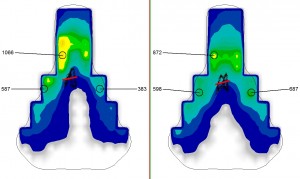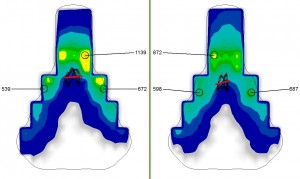Pay attention when buying cycling bibshorts!
When dealing with the contact point saddle in bikefitting, our goal is to match all the involved elements to each other. Adjusting the saddle type alone might only lead to partial improvements, and other parameters such as the saddle height, saddle position and tilt should be considered. Additionally, also the choice of the cycling bibshorts plays a decisive role when optimizing the comfort!
In our concept-lab, we rather frequently find that the padding of the cycling bibshorts does not fit the rider’s hip anatomy. These are situations in which also the best saddle won’t solve present saddle discomfort completely. This is why I want to provide some recommendations for the correct short-selection from a biomechanical perspective.
1. Tasks of the cycling bibshorts
The bibshort is the layer between saddle and the rider’s pelvis. Biomechanically, its main task is to distribute and cushion the rider’s weight as applied to the saddle. A large contact area results in lower maximum pressure equaling an improvement in comfort. That is why the short’s pad is so important: Without this cushioning element the force that the rider applies to the saddle would be passed back to the pressure sensitive pelvic region virtually unfiltered. Even if the impact choosing a fitting saddle type has on pressure distribution is largest (possibly a 30-40% reduction in pressure), with an average reduction of 15-25%, the impact of the pad is large enough to get attention in every fitting.
The left side shows the pressure distribution in a test person with a neutral short (running thigh without pad), the right side shows the measurement with padded bibshorts
In this example, the pressure is reduced by approximately 25%. The individual pressure spots are still identifiable but are cushioned by the pad and the overall contact area becomes larger. The cushioning that the pad provides also increases the pelvic stability on the saddle, as the more regular pattern of the central pressure point shows (black line).
Recommendation 1: For regular cycling tours with a duration of more than 30 minutes a padded cycling short is recommended!
2. Bibshorts and rider’s position
The search for the fitting bibshort should account for the position of the rider. The sportive, stretched position that 90% of all road cyclists and triathletes choose puts different demands on the pelvic tilt and accordingly the pad than the more upright position we find on commuter, touring and mountain bikes. Overall, the pad should cushion the area the athlete puts most force on when cycling: – For sportive positions in the front area of the pelvis to cushion the pubic bone and symphysis – For moderately sportive position especially the pad’s mid-section is important and the cushioning should be provided extensively towards both front and back – For more comfortable, upright position in the rear pelvic area to improve the pressure distribution under the sit bones
Recommendation 2: Don’t evaluate a new cycling short when standing upright but in relation to the real position on the bike!
3. Lumps and bumps: The pad’s outer
What is true for saddles is also true for pads: The area of contact should be large enough to cover the whole underside of the pelvic bone. If the pad is too narrow, the bone structure chafes over an edge or seam – regularly with each pedal stroke. This chafing movement is repeated approximately 4000 times per hour and enormously stresses the skin. As the width of the pelvis differs from person to person, the question of the optimal pad width needs to be answered on an individual basis! 
Comparison of the pressure distribution between two pad widths (left = too narrow, right = optimal)
The measurement shows that the pad on the left side is too narrow, while the pad on the right side has an optimal width. In comparison to the neutral shorts, the narrow pad cushions somewhat but only reduces the pressure by 7%, while a reduction of 25% is achieved with the optimal pad. The pressure spots in the measurement on the left side are especially at the outer edges, illustrating the friction created by the pad’s seam. By the way, there is no relation between pelvic width and body height. Accordingly, a taller person does not automatically have a wider sit bone distance. The rider’s position is of utmost importance in defining the contact between pelvis and saddle! With new methods using pressure mapping specialist dealers can determine an individual’s pelvic position on the saddle. This analysis results in the individual pelvic index, which eases finding the matching pad width.
Recommendation 3: Use the expertise of your specialist dealer or bikefitter to measure your individual pelvic index!
4. Breathability
While the pad should not be too narrow, it should not be too wide either as the pad area is not nearly as breathable as the surrounding Lycra. Being able “to breathe” is very important for the skin, as the natural pelvic movement and the time on the bike lead to heat and transpiration. As humidity increases – think warm weather but also rain – this becomes even more important. Keeping the skin as dry as possible is thus another important function that a cycling short should fulfill.
Recommendation 4: Pay attention to the optimal pad width – neither too narrow nor too wide is advisable!
In summary, the selection of the cycling bibshort is key for the comfort on the bike. This is another important aspect in bikefitting that is decisive for a relaxed and enjoyable ride. The buying decision should be taken individually, taking the pelvic form and rider’s position into account.
Author: Daniel Schade



